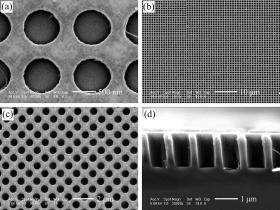May 7, 2010 feature
Silicon nanohole solar cells aim to make photovoltaics cost-competitive

(PhysOrg.com) -- Due to the increasing demand for renewable energy sources, photovoltaic solar cells have advanced significantly over the past decade. Since 2002, photovoltaic production worldwide has been doubling every two years, making it the world’s fastest-growing energy technology. However, the overall energy conversion efficiency of photovoltaics is still too low to be cost-competitive with fossil fuels, and so it has not been widely deployed.
In an attempt to change this, scientists have recently developed a novel silicon solar cell that has a unique geometry of nanoholes with diameters of about 500-600 nanometers. By achieving a power conversion efficiency of 9.5%, the new design boasts a superior performance compared with its silicon counterparts, such as solar cells that incorporate nanowires, nanotubes, and other optically active nanostructures. The best of these designs has an efficiency of a little more than 5%.
The researchers of the new study, Kui-Qing Peng of Beijing Normal University, Shuit-Tong Lee of the City University of Hong Kong, and their coworkers, have published their results in a recent issue of the Journal of the American Chemical Society. In their experiments, the scientists used a combination of deep ultraviolet lithograpy and metal-catalyzed electroless etching of silicon to fabricate the nanoholes on silicon wafers.
As the researchers explain, the key to the improved performance of the nanohole solar cell is that the nanohole arrays have better absorption than nanowires. Particularly, the vertically configured radial p-n junctions enable the electric current to travel only short distances between junctions for efficient current flow. In addition, the nanohole solar cell has shown to have superior mechanical robustness compared with the fragile structures of solar cells that have free-standing nanowire p-n junctions. In the past, this fragility problem has caused serious setbacks for manufacturing photovoltaic applications.
“The nanohole geometry solar cells possesses a robust structure compared with fragile free-standing nanowire geometry, a better ability for capturing sunlight than nanowire arrays, and radial p-n junctions allowing for enhanced carrier collection,” Lee summarized to PhysOrg.com.
Overall, the results demonstrate that the nanohole geometry has the potential for energy-efficient and cost-efficient photovoltaic solar energy conversion. The scientists plan to further improve the performance in several ways, such as by improving the coupling of light into the device, employing surface passivation to minimize surface recombination, and incorporating better electrical contacts.
“High optical absorption plus better carrier collection efficiency in nanohole geometry solar cells can be fabricated with less silicon materials and lower quality silicon,” Lee said. “These benefits would lead to efficient and less expensive solar cells, offering potentially competitive performance with traditional silicon-wafer cells, as well as cost-competitiveness with fossil fuels in the future.”
More information: Kui-Qing Peng, et al. “High-Performance Silicon Nanohole Solar Cells.” J. Am. Chem. Soc. Doi:10.1021/ja910082y
Copyright 2010 PhysOrg.com.
All rights reserved. This material may not be published, broadcast, rewritten or redistributed in whole or part without the express written permission of PhysOrg.com.



















